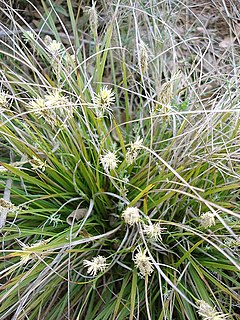
Carex is a vast genus of more than 2,000 species of grass-like plants in the family Cyperaceae, commonly known as sedges. Other members of the family Cyperaceae are also called sedges, however those of genus Carex may be called true sedges, and it is the most species-rich genus in the family. The study of Carex is known as caricology.

Bowerchalke Downs, is a 128.6 hectare biological Site of Special Scientific Interest in Wiltshire, notified in 1971. The downs encompass the entire southern outlook of the village of Bowerchalke in the Salisbury district of Wiltshire, England, and are adjacent to both the Hampshire and Dorset county boundaries. The Bowerchalke Downs are located within the Cranborne Chase and West Wiltshire Downs Area of Outstanding Natural Beauty and are part of the Southern England Chalk Formation.

Lambert's Castle is an Iron Age hill fort in the county of Dorset in southwest England. Since 1981 it has been designated as a Site of Special Scientific Interest (SSSI) on account of its geology, archaeology and ecology.

Dulichium is a monotypic genus of sedge containing the single species Dulichium arundinaceum, which is known by the common name threeway sedge. This is an aquatic or semi-aquatic plant of the lakes, streams, and ponds of the United States and Canada It has a wide distribution across the two countries, though noticeably absent from the Dakotas and from the Southwestern Deserts.
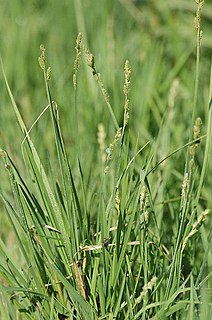
Carex canescens L. is a perennial species of plants in the family Cyperaceae growing in damp forests and wetlands. It is widespread across much of Europe, Asia, Australia, New Guinea, North America, and southern South America.

Carex luzulina is a species of sedge known by the common name woodrush sedge.

The Bottoms is a Site of Special Scientific Interest in County Durham, England. It lies just south of the A181 road, roughly midway between the villages of Cassop and Wheatley Hill, some 10 km south-east of Durham city.
Kenneth Kent Mackenzie (1877–1934) was a lawyer and amateur botanist who wrote extensively on the genus Carex in North America. The standard author abbreviation Mack. is used to indicate this person as the author when citing a botanical name.
Carex aztecica is a species of flowering plant in the sedge family, Cyperaceae. It is native to Central America.
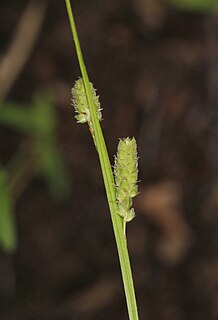
Carex swanii, known as Swan's sedge or downy green sedge, is a species of flowering plant in the family Cyperaceae. It is native to eastern North America.

Carex colchica is a species of perennial plant in the family Cyperaceae.

Carex albicans, commonly called whitetinge sedge, is a species of flowering plant in the sedge family (Cyperaceae). It is native to the eastern North America, where it is found in Canada and the United States. Its typical natural habitat is dry forests and woodlands.

Carex tenera, known as quill sedge, is a species of sedge native to the northern United States and Canada.

Carex flexuosa, commonly called flexuous white-edge sedge, or Rudge's white-edge sedge, is a species of flowering plant in the sedge family, Cyperaceae. It is native to the eastern North America, where it is found in eastern Canada, the northeastern and midwestern United States, and southward in the Appalachian Mountains. Its natural habitat is in upland forests, rock outcrops, and Appalachian balds. It is typically found in areas with acidic soil.
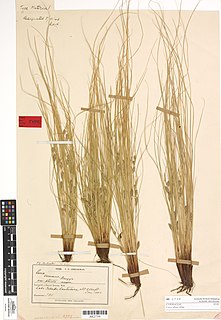
Carex albula, common name white sedge, is a species of sedge. It is endemic to the South Island of New Zealand.

Carex viridula, known as little green sedge, green sedge, or greenish sedge, is a small flowering plant native to North America, Europe, Asia, and Morocco.
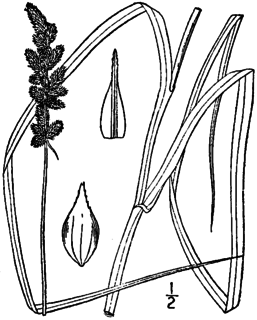
Carex annectens, sometimes called yellow-fruited fox sedge, is a species of sedge native to most of the eastern United States and southeastern Canada. It is common in prairies and high-water table fallow fields. In the Chicago area, its coefficient of conservatism is 3, and in Michigan, it is only 1, indicating its relatively low fidelity to high quality habitats.















